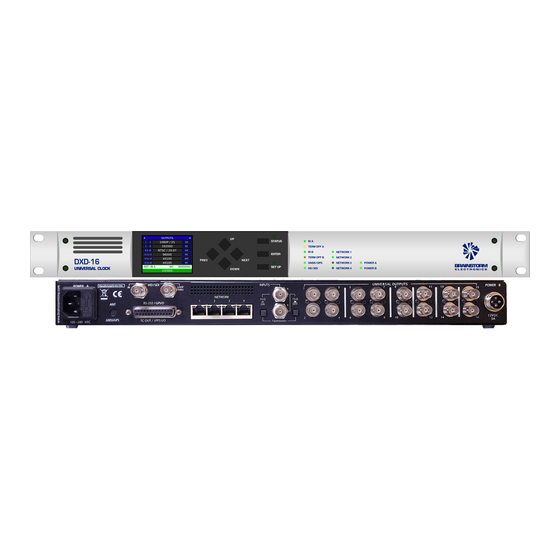Table of Contents
Advertisement
Quick Links
DXD/GPS
GPS option for the DXD Universal Clock
DXD/OCXO
OCXO option for the DXD Universal Clock
Operations manual
Version 2.10
January 2021
All materials herein © Brainstorm Electronics, Inc.
Brainstorm Electronics reserves the right to change or modify the contents of this manual at any time.
Brainstorm Electronics, Inc.
www.brainstormtime.com
Advertisement
Table of Contents

Summary of Contents for Brainstorm Electronics DXD/GPS
- Page 1 OCXO option for the DXD Universal Clock Operations manual Version 2.10 January 2021 All materials herein © Brainstorm Electronics, Inc. Brainstorm Electronics reserves the right to change or modify the contents of this manual at any time. Brainstorm Electronics, Inc. www.brainstormtime.com...
-
Page 2: Table Of Contents
10.2 PRECISE TIME-OF-DAY SOURCE ................10.3 SYNCHRONIZING DXD’S IN REMOTE LOCATIONS ..........11. Appendix ..........................11.1 Appendix A: Installing the DXD/GPS ................. 11.2 Appendix B: Installing the DXD/OCXO ..............11.3 Appendix C: GNSS Antenna Recommendations ............10.3.1 RECOMMENDED ACTIVE ANTENNA ............... -
Page 3: Introduction
1. Introduction The DXD Universal Clocks offers different hardware options. This manual covers the DXD/GPS and the DXD/OCXO. Designed to be the central source of time in a modern A/V installation, with these options, the DXD can fulfill that role more completely as they provide even more stable references. -
Page 4: Gps Receiver
Once the GPS receiver is installed in your DXD, an antenna will need to be connected to the receiver’s SMA connector (an antenna is not included with the DXD/GPS). The cable with an SMA-Male connector on the DXD side is required. -
Page 5: Gps Menus
DXD/GPS/OCXO User Manual (rev 2.10) Page 5 5. GPS Menus The GPS menus will only appear when the GPS receiver (DXD/GPS) is installed in your DXD. Otherwise the following message will appear: DXD/GPS NOT INSTALLED The GPS Receiver is required for these menus. -
Page 6: Advanced Gps Settings (Menu 6.3)
Main Rotation displays. GPS: A new choice in the Source field when the DXD/GPS option is installed is GPS. GPS acts very much like Input A or B. When selected in menu 1.1, it becomes the DXD reference. If GPS reception drops out, the DXD will switch to internal crystal until GPS reception resumes. -
Page 7: Time Of Day
& time, that information is transferred to the TOD. Although the RTC is set at the factory, it can also be set manually by the operator. Auto Update RT Clock With the DXD/GPS installed, the RTC can be updated automatically (menu 7.2). -
Page 8: Time Jam
DXD’s System Time will be reset to the time-of-day of the master source before locking to the BNC input. Time Jam To GPS With the DXD/GPS option installed, GPS can be selected as a source for a Time Jam in menu 1.2. See chapter 6 above for more information. -
Page 9: Display
DXD/GPS/OCXO User Manual (rev 2.10) Page 9 9. Display 9.1 Main Rotation Footer GPS: The DXD can lock to GPS a couple of different ways and will be shown accordingly on the display. • When GPS is selected as the reference in menu 1.1, it appears in the REF line at the bottom of the display. -
Page 10: Times Status Page
PTP epoch of Jan 1 1970 at 12AM. With the DXD/GPS, the DXD has access to the extremely accurate Time-Of-Day from the GNSS satellites. 10.3 SYNCHRONIZING DXD’S IN REMOTE LOCATIONS One of the great advantages of using the GNSS signal as a reference is to synchronize units in remote locations. -
Page 11: Appendix
As always with ribbon cables, make sure the connectors are properly oriented do that the ridge on the plug goes into the slot in the wall of the socket. Note that some early DXD-16 (s/n 1001-1047) may require a small modification to install the DXD/GPS, documented in TB121. 11.2 Appendix B: Installing the DXD/OCXO Installation should be performed carefully by a qualified person, using the usual precautions. -
Page 12: Appendix C: Gnss Antenna Recommendations
11.3 Appendix C: GNSS Antenna Recommendations Below are recommendations for active and passive antennas. Both can be used with the DXD/GPS. However, the distance between the antenna and the receiver is an important factor in selecting the proper antenna. The GPS signal is very weak and needs to be amplified to travel down a long cable to the receiver. -
Page 13: Appendix D: Factory Presets
DXD/GPS/OCXO User Manual (rev 2.10) Page 13 11.4 Appendix D: Factory Presets The following are the factory default settings for the new GPS menus: SATTELITE SELECTION GLONASS GALLILEO QZSS LIC/A SBAS DIF FIX SBAS / QZSS LIS GPS SETTINGS ANTENNA CABLE DELAY... - Page 14 Page 14 DXD/GPS/OCXO User Manual (rev 2.10)


Need help?
Do you have a question about the DXD/GPS and is the answer not in the manual?
Questions and answers